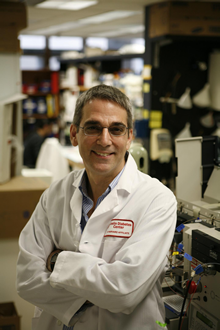Joslin research boosts evidence for a new class of treatments to help preserve vision in people with diabetes, including diabetic macular edema and retinopathy.

Diabetic macular edema (DME) is a leading source of vision loss around the world, affecting about a fifth of people with long-term diabetes.
Drugs that target a protein known as VEGF (vascular endothelial growth factor) inside the eye have greatly improved the treatment options in recent years, but only about half of DME patients are fully responsive to these new therapies.
Research in the lab of Edward P. Feener, Ph.D., Investigator in the Section on Vascular Cell Biology and Director of the Proteomics Core at Joslin Diabetes Center and an Associate Professor of Medicine at Harvard Medical School, now has shown that a substantial percentage of patients with DME do not have high levels of VEGF in the fluid inside their eyes but do have high levels of a protein called PKal (plasma kallikrein) and associated molecules that are key players in an inflammatory molecular pathway involved in the disease.
The scientists also have demonstrated in animals that the PKal molecular pathway can induce retinal edema through mechanisms that are independent of the VEGF pathway, which at normal levels helps to build and maintain blood vessels but at high concentrations can induce abnormal vessel growth and contribute to DME.
Outlined in a paper published in Diabetes, the discoveries boost the evidence that agents targeting PKal eventually may be useful in treating DME that is not fully responsive to VEGF inhibitors.
Continue Reading Below ↓↓↓
In August 2014, KalVista Pharmaceuticals Ltd. launched an early phase clinical trial of a PKal inhibitor to treat DME, with Jennifer Sun, M.D., Ph.D., of Joslin’s Beetham Eye Institute as principal investigator. Development of this drug was based on earlier work by Dr. Feener’s lab, which showed that activation of PKal can induce retinal edema in experimental models of diabetic retinopathy.
DME is a form of diabetic retinopathy in which blood vessels leak fluid into the macula (the region in the center of the retina that provides straight-ahead vision), which swells and blurs vision.
The condition has been treated at advanced stages by laser photocoagulation and steroids, which are effective for some individuals but are often associated with complications. The VEGF inhibitors that have arrived in recent years are injected into the eyeball initially on a monthly schedule.
They have been shown to be highly effective for many DME patients, but up to half of patients respond slowly, partially, or not at all. “We can’t really predict at this stage who will respond,” Dr. Feener says.
“DME is a leading cause of vision impairment and loss in those with diabetes. Although anti-VEGF therapies have proved effective in some people with the condition, additional therapies are needed to complement existing ones and to treat individuals who do not respond to currently available therapies. Dr. Feener’s work is critical in elucidating one such potential target for a new DME therapy,” said Helen Nickerson, Ph.D., Director of Translation Research at JDRF, which helped support Dr. Feener’s research.
In the study, Joslin researchers examined samples of vitreous (eyeball) fluid from 61 patients with diabetic retinopathy or control group with a non-diabetic form of macular damage. They found that that the DME patients divided into two groups, one with high levels of both PKal and VEGF proteins, and the other with high levels of PKal but not VEGF.
Following up using proteomics (a large scale analysis of proteins) of vitreous samples from patients with DME, the scientists discovered that the proteins that appear in high abundance in DME are associated more with PKal than VEGF. “This tells us again that DME is a heterogeneous condition and that VEGF-independent mechanisms contribute to this disease,” Dr. Feener says.
Among their additional work in animal models, the scientists showed that diabetic rats that received human DME fluid high in PKal-related proteins but low in VEGF developed increased leakage from retinal blood vessels. This leakage could be blocked by an agent targeting the PKal pathway but not by a VEGF inhibitor. Additionally, diabetic mice genetically modified to lack PKal showed far less retinal blood vessel leakage than wild-type mice.
“Our findings suggest that heterogeneity of protein changes in DME may partly explain the difference in response to anti-VEGF therapy, and that increased Pkal may be a therapeutic target for DME that is independent of changes in the VEGF pathway,” Dr. Feener says.
Overall, the research bolstered the case that the PKal pathway can be targeted by drugs independently of the VEGF pathway. “If this pathway turns out to be a significant contributor to DME, it potentially opens up another opportunity in the long term to develop an orally available PKal inhibitor to treat this disease,” he adds.
Continue Reading Below ↓↓↓
He notes that a PKal inhibitor is currently used to treat people with hereditary angioedema. Moreover, people with a rare genetic deficiency in Pkal and mice genetically modified to lack PKal do not appear to suffer any undesirable consequences. These findings suggest that systemic blockade of PKal is well tolerated and effective in treating leaky blood vessels caused by another disease.
While it is very early days in the development of such treatments, “oral agents that could be used to treat DME would be a great advance,” Dr. Feener says. “We could reduce the dependency on intravitreal injections and perhaps consider treating patients earlier in the progression of the disease.”
The research was supported by JDRF, the Massachusetts Lions Eye Research Fund, and the National Institutes of Health. Lead author was Takeshi Kita. Joslin’s Lloyd Paul Aiello, Allen Clermont, Nivetha Murugesan, and Qunfang Zhou were co-authors, along with Kimihiko Fujisawa and Tatsuro Ishibashi of Kyushu University.
Source: Joslin Diabetes Center
Journal: Diabetes










